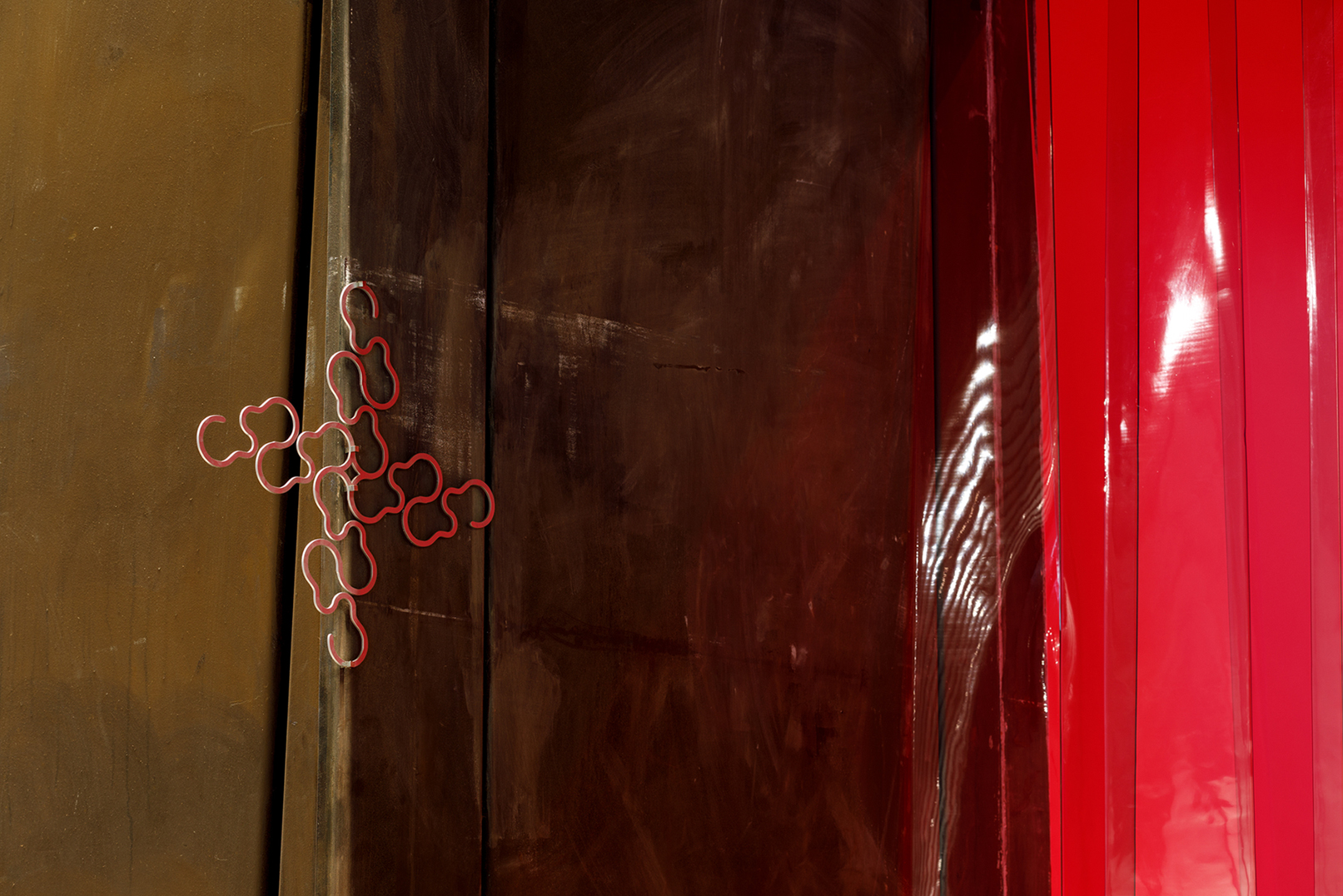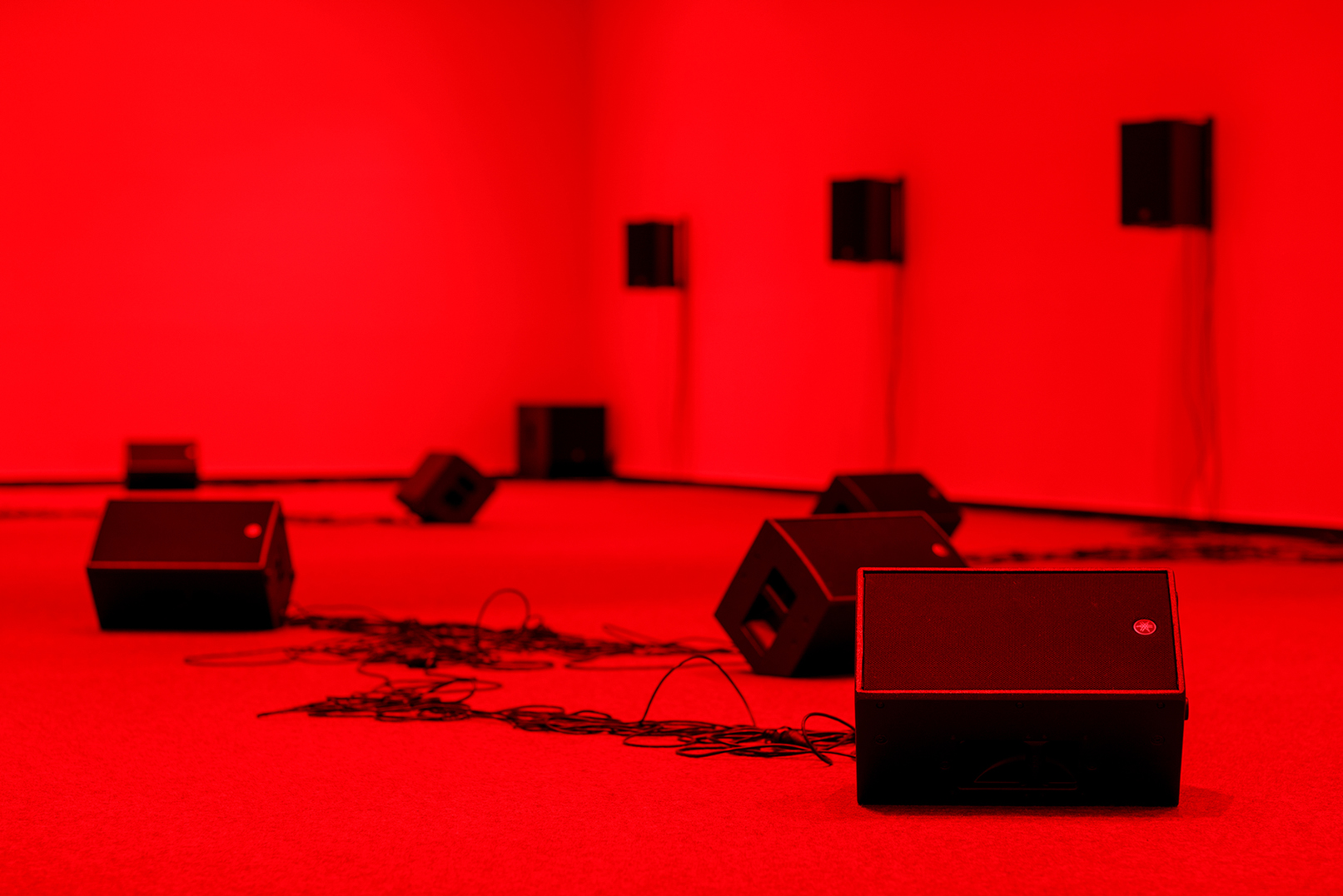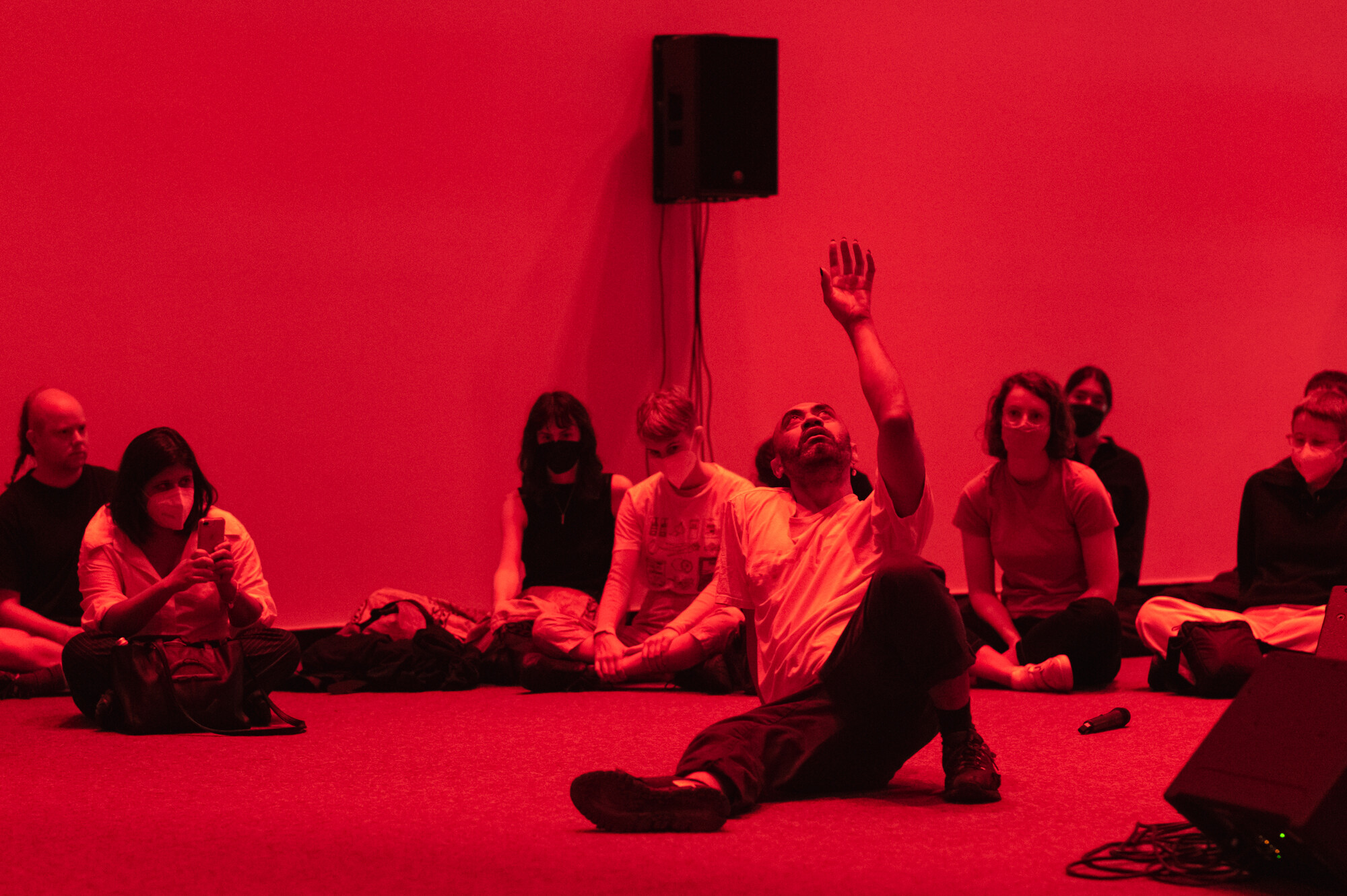Frances Barrett: Meatus
Chelsea Hopper
Back in the trauma-bonding year of 2020, a promotional image for the long-postponed Meatus fell into my inbox. Pictured in a cropped photograph was the profile of writer and performance artist Brian Fuata—his ear adorned with a thick, silver earring dangling out of the frame. I assumed it was performance documentation but now realise, two years on at the finally launched exhibition at ACCA, the promotional image actually documents an earring by Debris Facility, one of six contributors to Meatus. The curly appendage was an apt incursion into the exhibition’s marketing as it turns out to be in the exhibition itself, where Facility’s silver worm-like symbols are discreetly hung outside ACCA’s many vermiculated passageways, including pink glittery iterations stuck to its bathroom mirrors.

Meatus, pronounced mee-ay-tus, refers to an opening or passage leading to the interior of the body. Ear canals, nasal passages, urethras, all fit the bill. For the exhibition’s curator, Frances Barrett, meatus is also “a metaphor for a listening practice that de-centres the ear, that relies on a nexus of our senses”. As such, sound and light take centre stage in the exhibition, as the visual representations of the body are propelled to the back of the line and the threshold between the inside/outside of the body is unravelled in a myriad of ways by Barrett with her fellow collaborators.

As I part the thick plastic flaps (which carry fishy connotations of the Vic Markets’ meat section) at the gallery’s entrance, ACCA’s deep, red-lit space immediately reminds me of Destiny Deacon and Virginia Fraser’s installation Colour Blinded (2005), exhibited at last-year’s NGV retrospective but originally shown seventeen years ago here at ACCA. In that work, commercial low pressure sodium lamps created an intense radioactive yellow hue that instantly turned my skin to a sickly greyish tone. Less morbid, Meatus’ spectrum of red and pinkish tones cultivates a deep sense of awareness of your own body. Here, Barrett’s red gesture extends to us a new queer subjectivity, one that is psychically and energetically charged and shared.

The colour red is pregnant with a range of common signifiers: danger, passion, power, love, sex, anger, violence. Sitting in the large, red-lit gallery space, clocking thirty-one metres in length (slightly bigger than a full-grown blue whale) there is a mixed physical sensation of being lost in the pits of the deepest sea, returned to a maternal womb, or floating inside a stretched-out, oversized red blood vessel. The only objects visible within the space are heavy-looking speakers under the red saturated light, evenly spaced and lining the ceiling and walls with black cables trickling down, along with a handful dotted on the carpeted floor.

This immersive sound installation titled worm divination (segmented realities) (2020) I later find out also has 3D spatial audio rendering, aimed to generate the same quality of sound no matter where you sit or stand in the room. Just over thirty-minutes, worm divination cycles through a range of drastically intense sounds, from screaming incoherence to repetitive chanting, all voiced by Brian Fuata. Fuata’s wailing, wandering articulations—unlike his live performances, which always abruptly end after a strict period of time—are distorted, abstracted and looped, echoing sporadically through a mixture of the thirty-nine speakers scattered around the room. There are moments when you can hear him “sound out” or attempt to form parts of language within his mouth, which then become sonically stretched, sped up or slowed down lending a heavy, burrowing quality that reverberates with the help of the Yamaha sub-woofers. Humming, uttering, murmuring, clicking the tongue sounds are followed by slowed down deep exhalations and trailed by the enunciation of words from the English language that spit back out at us as: “cum”, “wah”, “hole”, “now”. I’ll get back to the significance of these particular words later.
Listening closely at the short-lived moments of the audio, Fuata’s modified voice—presumably caused by the installation’s sound design—takes on strange remnants of The Man from Another Place, that diminutive character dressed in a red suit from David Lynch’s serial drama Twin Peaks, famously known for speaking backwards. The “reverse-speech”—speaking a line forward, listening to the backwards playback and then repeating it—is riddled with cryptic messages, which end up leading to clues for Kyle MacLachlan’s protagonist, special agent Dale Cooper. Another parallel is that the red room is also known as “the waiting room”—a mysterious anomalous extradimensional space to somewhere else, a kind of meatus itself. Like Lynch, Barrett puts great emphasis on waiting, listening and feeling for hidden connections. The aural, physical or even psychological tensions within worm divination (segmented realities) build over time—as Barrett relays to us in the accompanying text, “like the wormhole, listening takes time”.

At last the words “wormhole”, “mouth”, “come”, blare out and then evolve more explicitly to say: “you / fuck me / worm hole / a passage / my whole passage / you fuck my (w?)hole passage”. The wormhole Fuata speaks of could be read by way of definition: a tunnel-like connection through space-time. But which end did I just reach? Or am I caught in the throat? The wall label also denotes the wormhole as “a compositional structure replicating the segmented body of a worm, beginning in the mouth and moving through to the anus”.
As a skinny, pocket-size take away book with a glossy pink cover, Curator’s Talk—penned by Barrett—was also performed as a reading (as it is instructed to do so in the book) on the Saturday following the opening night of Meatus. Barrett begins by declaring her position as an “artist-cum-curator” (surely a meatal pun) as one that entails speaking for or as “both an artist and a curator, speaking with two mouths”. One senses in Barrett an anxiety, or even indecision, about her relation to the figures of the artist and the curator (and the traditional forms of power and responsibility that come with each). She wiggles worm-like around the roles as if in search for a way out—which is, as the idea of meatus captures, also a way into something else. For Barrett this something else is collaboration, which she frames as a queering of the role of the curator.

In an interview with then-commissioning curator Annika Kristensen, Barrett discusses the way of collaborating (between herself, Fuata and Hayley Forward) as like a worm: the “worm was a way to compost language, the body and performance, decomposing, recomposing, into sonic force”. Barrett’s publication, Curator’s Talk, partly elaborates on the wormhole’s multiplicities that relate the many references underpinning the work: whether literary or cultural theory, ranging from William Burroughs to Donna Haraway. All of them contribute to the discourse on “queer political imagining”.

Each of the rooms adjacent to the main exhibition space is devoted to commissioned sound installations by artist and musician Del Lumanta, Sione Teumohenga and composer Nina Buchanan. Leaving the seductive long red room, the works in these next rooms demand of the visitor a degree of patience. This is partly because the audio is programmed to play according to the succession of linear time: you must wait at least fifteen minutes until the next work loops in if you really want to hear it. I instead imagine the works being played all at once, as is more typical in exhibitions of contemporary art—where the audience is afforded more agency in determining their pathway through the works and the duration they spend with them. Would this way of active listening balance out our relationship to these spaces? In what way would attention to one composition also require our active silencing of the other distracting ones? Instead, the silencing is made for us, with only one work playing at a time (each in a separate room), so that while one plays, the other two await silently their turn. Perhaps there was a fear of the abject cacophony of sounds, like our meatuses, which are full of shit, snot, earwax, dirt and debris.

The series of live performances by Brian Fuata, Nina Buchanan and Sione Teumohenga following Barrett’s reading over the opening weekend solidified how improvisation, its “liveliness”, at least for me, is best seen, felt and heard in real time. Its appeal to realness or here queer realism, a term coined by late Christopher Chitty, is useful to recognise as a “performative intervention … as this kind of realness has historically provided queers with rhetorical strategies for questioning dominant ideologies while nonetheless moving within them”. Is Fuata actually embodying some kind of queer utopian imaginary? As Chitty suggests, “realness has the meaning of subjectivating a sense of what is possible”. Perhaps as I watch Fuata jolt, crawl and weave around that packed audience, at times pointing to, leaning on or even snuggling up to visitors for a moment, he is. Or the same could be thought of by watching Teumohenga’s gentle toing and froing, as their thick long locks of hair wave about, camouflaging their guitar letting out some of the most violent thrashes of noise I’ve ever heard—so loud I feel like my body is being ripped apart. When I watch a couple opposite me during the final performance by Nina Buchanan, sliding down onto the carpeted floor with their eyes closed, I know I will never hear anything like this again.
Chelsea Hopper is a curator and writer who runs 99%, a gallery housed in the Nicholas Building.